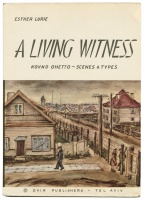
A Living Witness: Kovno Ghetto - Scenes & Types
| Author: | Esther Lurie (1913–1998) |
Esther Lurie (b. 1913 Liepaja, Latvia – d. 1998 Tel Aviv) having studied at the Hebrew Gymnasium in Riga, Esther Lurie enrolled in the Institute of Decorative Arts in Brussels in 1931, and later studied at the Royal Academy of Arts in Antwerp. She emigrated to Tel Aviv in 1934 and found a job as a scenery painter in a theatre. She worked mostly in ink and watercolours. In 1939 she went to Kaunas to visit some relatives, studied under Justinas Vienožinskis, and held exhibitions in 1939 and 1940. After the Nazis occupied Kaunas, Lurie was imprisoned in the ghetto, and was later transferred to the Stutthof concentration camp and the Leibitz women’s forced labour camp. She depicted the atrocities committed in the ghetto and the concentration camps in dozens of drawings. In 1945, she returned to Tel Aviv, worked hard, participated in exhibitions, and published several sketchbooks: Women’s Labour Camp, Kaunas Ghetto and Jerusalem. In 1938 and 1946, she won the Dizengoff Prize, and in 1966 she won a gold medal at the international women’s exhibition in Vichy in France.
Source: Ellex Valiunas (LAWIN until 2015) art album: STORIES OF LITVAK ART (2023). Compiler and author Vilma Gradinskaitė.

Esther Lurie (b. 1913 Liepaja, Latvia – d. 1998 Tel Aviv) having studied at the Hebrew Gymnasium in Riga, Esther Lurie enrolled in the Institute of Decorative Arts in Brussels in 1931, and later studied at the Royal Academy of Arts in Antwerp. She emigrated to Tel Aviv in 1934 and found a job as a scenery painter in a theatre. She worked mostly in ink and watercolours. In 1939 she went to Kaunas to visit some relatives, studied under Justinas Vienožinskis, and held exhibitions in 1939 and 1940. After the Nazis occupied Kaunas, Lurie was imprisoned in the ghetto, and was later transferred to the Stutthof concentration camp and the Leibitz women’s forced labour camp. She depicted the atrocities committed in the ghetto and the concentration camps in dozens of drawings. In 1945, she returned to Tel Aviv, worked hard, participated in exhibitions, and published several sketchbooks: Women’s Labour Camp, Kaunas Ghetto and Jerusalem. In 1938 and 1946, she won the Dizengoff Prize, and in 1966 she won a gold medal at the international women’s exhibition in Vichy in France.
Source: Ellex Valiunas (LAWIN until 2015) art album: STORIES OF LITVAK ART (2023). Compiler and author Vilma Gradinskaitė.






